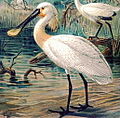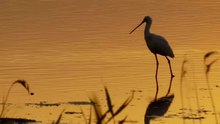Eurasian spoonbill
| Eurasian spoonbill | |
|---|---|

| |
| Adult in breeding plumage | |
| Scientific classification | |
| Kingdom: | Animalia |
| Phylum: | Chordata |
| Class: | Aves |
| Order: | Pelecaniformes |
| Family: | Threskiornithidae |
| Genus: | Platalea |
| Species: | P. leucorodia
|
| Binomial name | |
| Platalea leucorodia | |


The Eurasian spoonbill (Platalea leucorodia), or common spoonbill, is a wading bird of the ibis and spoonbill family Threskiornithidae. The genus name Platalea is from Latin and means "broad", referring to the distinctive shape of the bill, and leucorodia is from Ancient Greek leukerodios "spoonbill", itself derived from leukos, "white" and erodios "heron".[2] In England it was traditionally known as the "shovelard", a name later used for the Northern Shoveller.
Taxonomy and systematics[]

A study of mitochondrial DNA of the spoonbills found that the Eurasian spoonbill is sister taxon to a clade containing the royal and black-faced spoonbills.[3]


The Eurasian spoonbill has three subspecies:[4]
- P. l. leucorodia – Linnaeus, 1758: nominate, occupies all the range except as below.
- P. l. balsaci – Naurois & Roux, 1974: found on the islands off the Banc d'Arguin, Mauritania.
- P. l. archeri – Neumann, 1928: found on the coasts of the Red Sea and Somalia.
Birds in Asia are sometimes separated as P. l. major.
Description[]
This species is almost unmistakable in most of its range. The breeding bird is all white except for its dark legs, black bill with a yellow tip, and a yellow breast patch like a pelican. It has a crest in the breeding season. Non-breeders lack the crest and breast patch, and immature birds have a pale bill and black tips to the primary flight feathers. Unlike herons, spoonbills fly with their necks outstretched. The Eurasian spoonbill differs from the African spoonbill with which in overlaps in winter, in that the latter species has a red face and legs, and no crest.
They are mostly silent. Even at their breeding colonies the main sounds are bill snapping, occasional deep grunting and occasional trumpeting noises.
Distribution and habitat[]
This is a Palearctic species, breeding from the United Kingdom and Portugal in the west through to Japan, and also in North Africa. In Europe, only the Netherlands, Spain, Austria, Hungary and Greece have sizeable populations.[5] Most birds migrate to the tropics in winter, with European breeders mainly going to Africa, but a few remaining in mild winter areas of western Europe south to the United Kingdom. It was extirpated from the United Kingdom in the later part of the seventeenth century, although in the previous century it had been a widespread breeding species in the south-east, even near London. Sporadic breeding attempts in the early 21st century culminated with the formation of a colony at Holkham in Norfolk in 2010. In 2011, 8 breeding pairs nested, successfully fledging 14 young.[6]
Eurasian spoonbills show a preference for extensive shallow, wetlands with muddy, clay or fine sandy beds. They may inhabit any type of marsh, river, lake, flooded area and mangrove swamp, whether fresh, brackish or saline, but especially those with islands for nesting or dense emergent vegetation (e.g. reedbeds) and scattered trees or shrubs (especially willow Salix spp., oak Quercus spp. or poplar Populus spp.). Eurasian spoonbills may also frequent sheltered marine habitats during the winter such as deltas, estuaries, tidal creeks and coastal lagoons.[1]
Behaviour and ecology[]
Breeding[]
More northerly breeding populations are fully migratory but may only migrate short distances while other, more southerly populations are resident and nomadic or partially migratory. In the Palearctic, the species breeds in spring (e.g. from April) but in tropical parts of its range it times breeding to coincide with rainfall. Breeding is normally in single species colonies or in small single species groups amidst mixed-species colonies of other waterbirds such as herons, egrets and cormorants. Outside the breeding season Eurasian spoonbills forage singly or in small flocks of up to 100 individuals. Migration is usually conducted in flocks of up to 100 individuals. Most activity takes place during the morning and evening (although in coastal areas it foraging is governed by tidal rhythms), they often roost communally in roosts which are up to 15 km (9.3 mi) away from the feeding areas.[1]
The nest is a platform of sticks and vegetation which is either constructed on the ground on islands in lakes and rivers or in dense stands of reeds, bushes, mangroves or deciduous trees up to 5 m (16 ft) above the ground. Within colonies neighbouring nests are usually quite close together, no more than 1 or 2 m (3.3 or 6.6 ft) apart. Breeding colonies are normally sited within 10–15 km (6.2–9.3 mi) of feeding areas, often much less (although the species may also feed up to 35–40 km (22–25 mi) away).[1]
Feeding[]
The diet consists of aquatic insects, mollusks, newts, crustaceans, worms, leeches, frogs, tadpoles and small fish up to 10–15 cm (3.9–5.9 in) long. It may also take algae or small fragments of aquatic plants (although these are possibly ingested accidentally with animal matter).[1] They use sideways sweeps of their beaks to filter out the tiny fish and shrimps.[7]
Conservation[]
Threats to the Eurasian spoonbill include habitat loss and degradation by drainage and pollution, it is especially adversely affected by the disappearance of reed swamps. In Greece disturbance from fishing once caused the population to decline, and human exploitation of eggs and nestlings for food has threatened the species in the past.[1] As stated above, it has recently started to breed in the United Kingdom from where it was extirpated in the 17th century.[8]
The research network Eurasian Spoonbill International Expert Group was formed in 1991.[9] It made an action plan for the bird in 2008.[10] In 2013 the group joined the Agreement on the Conservation of African-Eurasian Migratory Waterbirds.
Gallery[]

Spoonbill at Gudavi
Nestlings

Immature Eurasian spoonbill, Bundala National Park


ID composite


Hieronymus Bosch: The Garden of Earthly Delights, 15th century

New International Encyclopedia, 1902

Naumann: Naturgeschichte der Vögel Mitteleuropas, 1905

USSR stamp, 1968

Museum specimen - île Kiji, Mauritania
References[]
- ^ a b c d e f BirdLife International (2019) [amended version of 2016 assessment]. "Platalea leucorodia". IUCN Red List of Threatened Species. 2016: e.T22697555A155460986.
- ^ Jobling, James A (2010). The Helm Dictionary of Scientific Bird Names. London: Christopher Helm. pp. 157, 309. ISBN 978-1-4081-2501-4.
- ^ Chesser, R. Terry; Yeung, Carol K.L.; Yao, Cheng-Te; Tians, Xiu-Hua; Li, Shou-Hsien (2010). "Molecular phylogeny of the spoonbills (Aves: Threskiornithidae) based on mitochondrial DNA". Zootaxa. 2603 (2603): 53–60. doi:10.11646/zootaxa.2603.1.2. ISSN 1175-5326.
- ^ Gill, F.; Donsker, D., eds. (2017). "IOC World Bird List (v 7.2)". doi:10.14344/IOC.ML.7.2. Retrieved 10 July 2017. Cite journal requires
|journal=(help) - ^ Overdijk, O. (2002). "Lepelaar Platalea leucorodia". Atlas van de Nederlandse Broedvogels 1998–2000 [Atlas of the Breeding Birds of the Netherlands]. Nederlandse Fauna 5 (in Dutch). Leiden: Nationaal Natuurhistorisch Museum Naturalis, KNNV Uitgeverij & European Invertebrate Survey-Nederland. p. 88. ISBN 978-90-5011-161-4.
- ^ "Breeding spoonbills return to Holkham". 12 September 2011. Archived from the original on 5 June 2014.
- ^ Attenborough, D. 1998 The Life of Birds. BBC books.ISBN 0563 38792 0
- ^ Unwin, Brian (27 August 2000). "Spoonbills return to breed in the UK after 300 years". The Independent. London.
- ^ https://www.unep-aewa.org/en/workinggroup/aewa-international-species-expert-groups-iseg
- ^ https://www.unep-aewa.org/en/publication/international-single-species-action-plan-conservation-eurasian-spoonbill-complete-ts
External links[]
| Wikimedia Commons has media related to Platalea leucorodia. |
| Wikispecies has information related to Platalea leucorodia. |
- BirdLife species factsheet for Platalea leucorodia
- "Platalea leucorodia". Avibase.

- "Eurasian spoonbill media". Internet Bird Collection.
- Eurasian spoonbill photo gallery at VIREO (Drexel University)
- Interactive range map of Platalea leucorodia at IUCN Red List maps
- Audio recordings of Eurasian spoonbill on Xeno-canto.
- IUCN Red List least concern species
- Platalea
- Birds of Eurasia
- Birds described in 1758
- Taxa named by Carl Linnaeus












